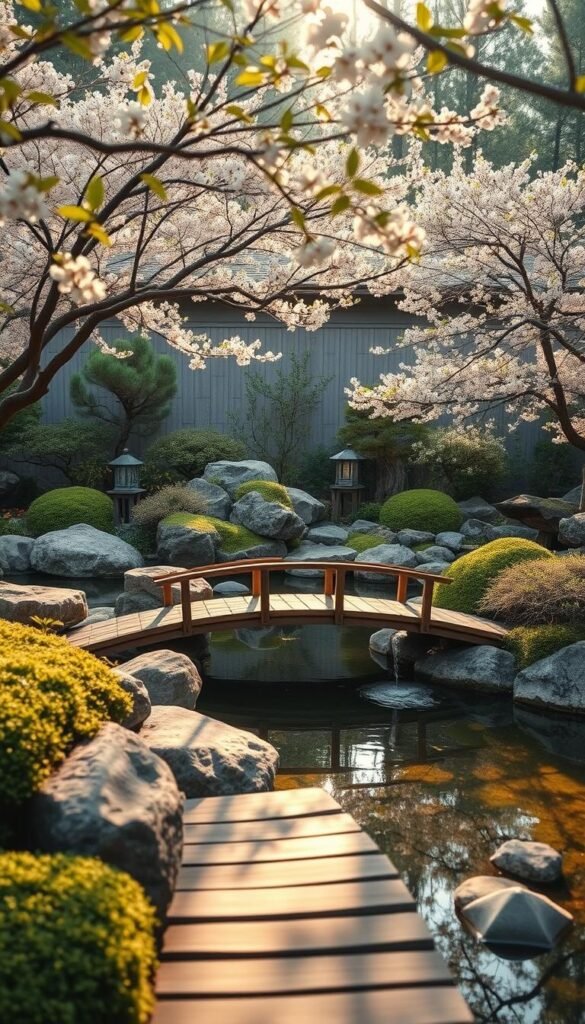Imagine stepping into a space where daily stresses dissolve into quiet contemplation. Rooted in centuries-old Japanese traditions, these serene landscapes blend simplicity with intentional design. Unlike typical garden aesthetics, every rock, raked gravel patch, and moss cluster serves a purpose—to mirror nature’s essence while inviting inner peace.
Originally crafted by Buddhist monks as meditation spaces, these designs prioritize balance over clutter. You don’t need a sprawling yard or rare materials to capture that calm. Even a modest corner can become your personal sanctuary. The key lies in understanding the philosophy behind each element, from stone placements symbolizing mountains to flowing sand patterns evoking water.
This guide simplifies the process, showing how to adapt ancient principles to modern homes. Whether you’re refining an existing outdoor area or starting fresh, you’ll learn to select materials that foster tranquility. Discover how strategic layouts and mindful plant choices turn ordinary spaces into reflective retreats.
Ready to transform your outdoor area? Let’s explore how blending natural textures and minimalist concepts—as detailed in this step-by-step resource—can craft a haven that feels both timeless and uniquely yours.
Introduction to Zen Garden Design
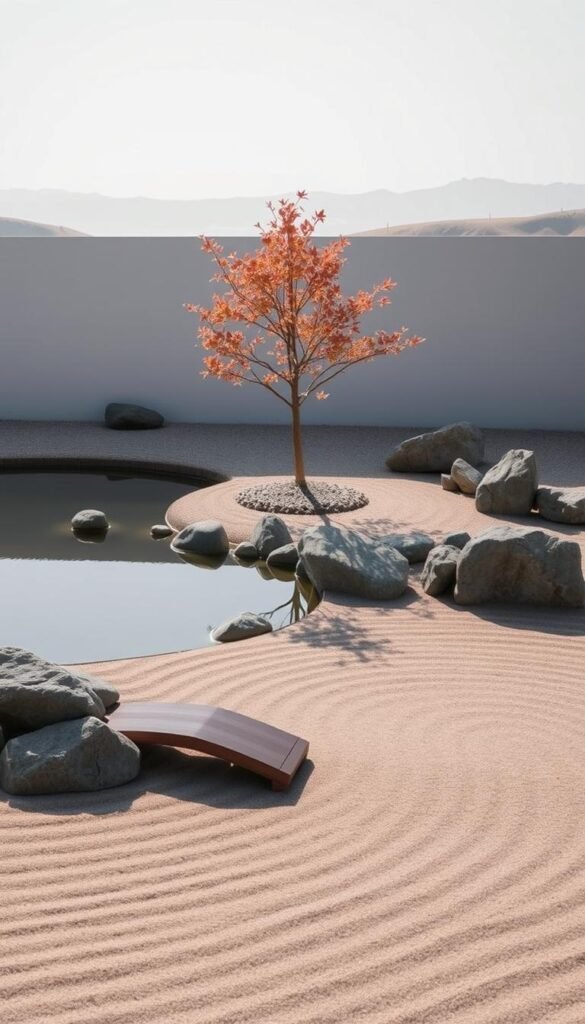
Rooted in sixth-century Japan, these landscapes began as monastic training grounds. Buddhist monks shaped stone and sand into visual koans – puzzles meant to spark enlightenment. Unlike decorative Western gardens, every element whispers ancient wisdom through deliberate placement.
Origins, Philosophy, and Cultural Influence
Seven core principles guide authentic zen gardens. Kanso (simplicity) demands uncluttered spaces, while Fukinsei (asymmetry) mimics nature’s imperfect balance. Dry landscapes (karesansui) use gravel swirls as water metaphors – a hallmark of traditional Japanese rock gardens.
Three main styles evolved: Hill gardens for strolling, tea gardens for ceremonies, and dry gardens for contemplation. Your backyard sanctuary draws most from karesansui – the ultimate meditation tool using only stones, moss, and raked patterns.
Benefits of a Tranquil Backyard Retreat
Modern science confirms what monks knew: Structured natural spaces lower cortisol levels by 16% (University of Minnesota study). Your personal refuge offers:
- Stress relief through rhythmic raking
- Sharper focus from minimalist design
- Deeper sleep patterns via evening contemplation
These spaces don’t just beautify yards – they rewire how we process daily chaos. By embracing zen principles, you create an anti-anxiety zone where phone alerts fade beneath wind-chime harmonies.
Selecting the Perfect Location for Your Zen Garden
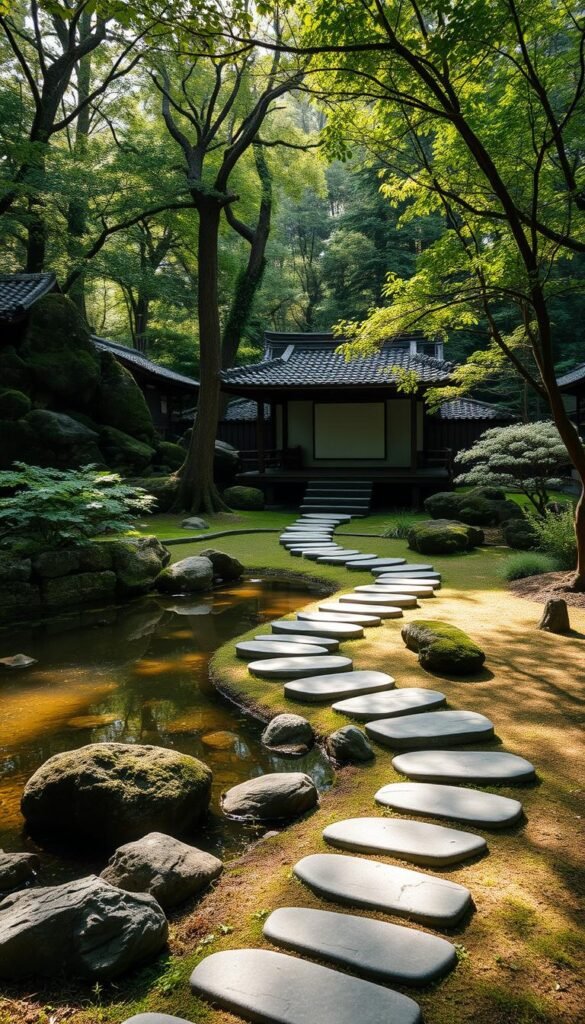
Where you place your sanctuary determines its power to calm. Start by walking your yard at different hours. Notice which space feels most removed from barking dogs or passing cars. A screened area near evergreen shrubs often works better than open lawns.
Sunlight Patterns and Landscape Harmony
Morning light creates soft shadows perfect for meditation, while afternoon sun might wilt delicate moss. Track how light moves across potential spots using this simple guide:
| Time | Ideal Use | Plant Impact |
|---|---|---|
| 6-10 AM | Meditation sessions | Ferns thrive |
| 10-2 PM | Pattern raking | Succulents prefer |
| 4-7 PM | Evening reflection | Hostas flourish |
Look for existing features that anchor your design. A mature maple tree’s roots could outline a gravel garden, while a sloped area might become a dry stream. Remember: Your retreat should feel like part of the landscape, not a staged exhibit.
Flat ground reduces construction headaches, but slight slopes (under 5°) help drainage. If your chosen space sits near a patio door, add bamboo screening. This maintains privacy while keeping the environment accessible for daily pauses.
How to Create a Zen Garden Backyard Retreat for Relaxation
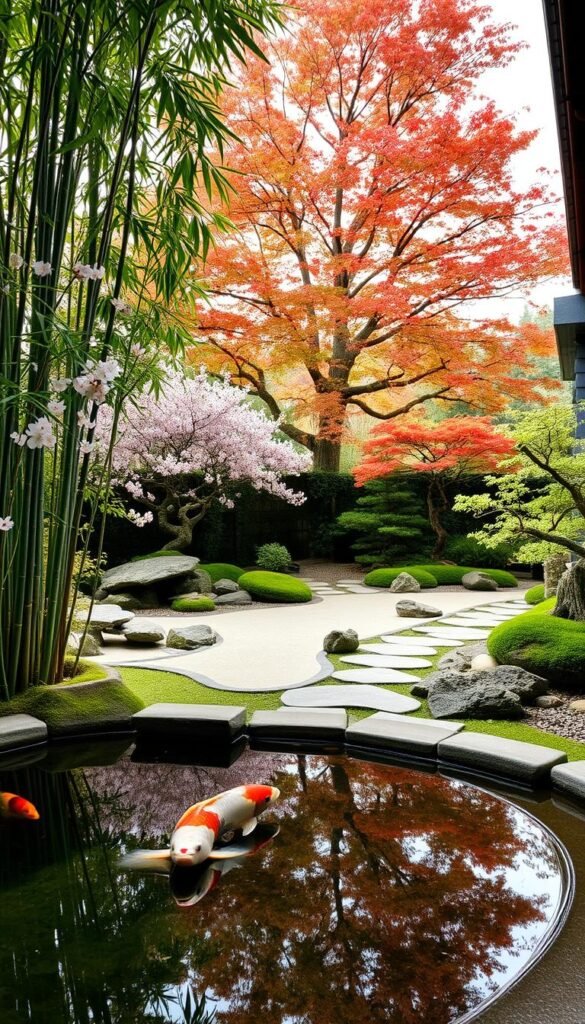
Your personal sanctuary begins with intention, not size. Before selecting stones or plants, ask yourself: What emotions do you want this space to evoke? The answer shapes every design choice, transforming generic elements into a reflection of your inner landscape.
Understanding the Vision for Your Personal Oasis
Start by mapping your daily rituals. Will you practice morning meditation here, or enjoy evening tea while listening to bamboo rustle? Those who prefer seated contemplation might prioritize smooth sitting stones, while visual learners could focus on raked gravel patterns.
Muted earth tones form the foundation, but your zen garden isn’t bound by strict rules. A slate-gray bench or rust-colored lantern can add personality without disrupting calm. One homeowner nestled a carved owl statue among ferns—a nod to her late father’s favorite bird.
Balance matters most. Traditional rock groupings (ishi-gumi) might share space with a modern steel water basin. Test layouts by sketching rough ideas on grid paper, remembering that asymmetry often feels more natural. The goal? A blend that whispers “peace” in your unique dialect.
Consider sightlines from indoor windows if you’ll view the garden daily. Those using it for active contemplation might screen it with tall grasses for privacy. Either way, ensure pathways feel inviting—you’ll create zen moments more often when access feels effortless.
Incorporating Essential Elements: Rocks, Gravel, and Sand
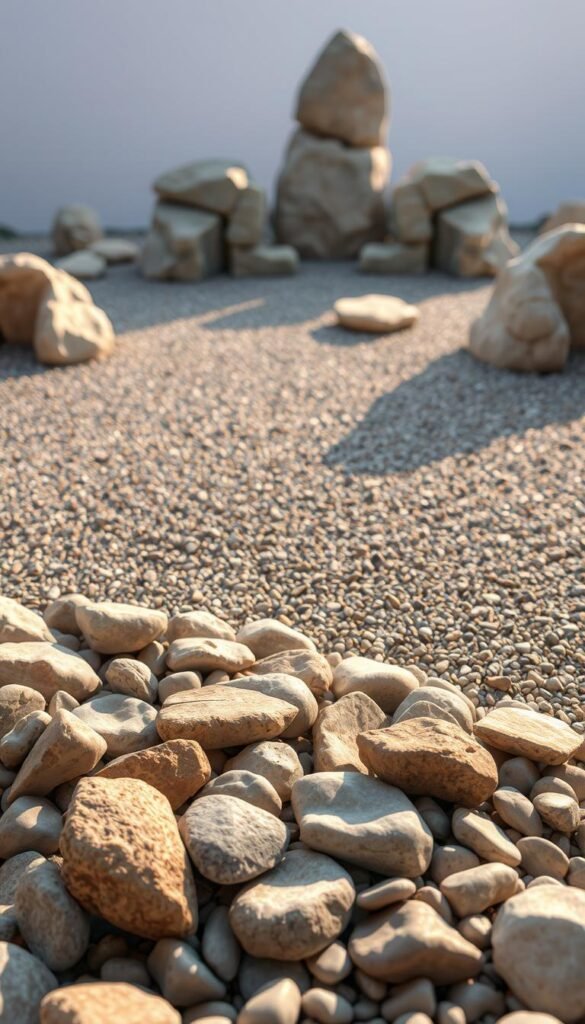
The soul of your sanctuary lies in its natural elements. Rocks anchor the space, gravel flows like water, and sand captures light. Together, they form a language older than words.
Choosing the Right Rocks and Boulders
Start with your largest stones—these become your garden’s bones. Odd-numbered groupings (3 or 5) create natural asymmetry. Place them at angles that mimic how they’d rest in nature, not perfectly upright.
| Rock Size | Purpose | Arrangement Tip |
|---|---|---|
| Large boulders | Focal points | Bury 1/3 underground |
| Medium stones | Balance clusters | Space 2-3 feet apart |
| Small pebbles | Path borders | Group in same-color batches |
Crushed granite gravel lasts longer than pea gravel. Choose 1/4″ size for crisp patterns. Light colors reflect moonlight for evening calm.
Raking Techniques for Peaceful Patterns
Your rake becomes a paintbrush. Start with basic lines before trying waves. Deep grooves (1/2″ depth) hold shape better. Rotate patterns weekly as moving meditation.
- Concentric circles: Symbolize life’s cycles
- Parallel lines: Guide focus inward
- Spiral swirls: Represent energy flow
Remember: Imperfections honor wabi-sabi philosophy. A crooked line or uneven spacing keeps the design alive, not frozen.
Enhancing Tranquility with Water Features
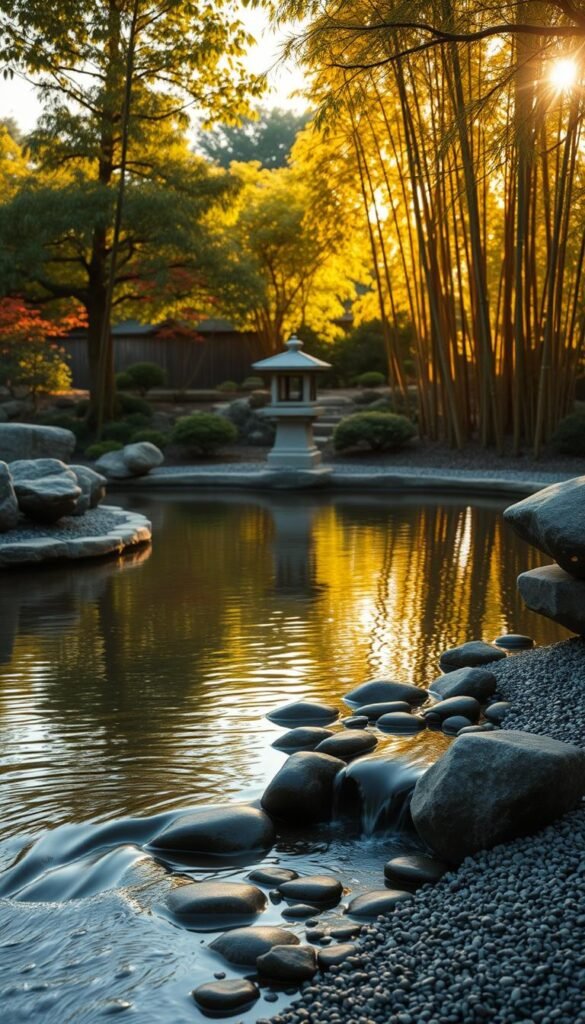
The gentle murmur of water transforms stillness into serenity. While traditional dry gardens focus on symbolic gravel “streams,” modern adaptations often incorporate actual water features to amplify relaxation. These elements introduce movement and sound, creating layered sensory experiences that deepen mindfulness practices.
Selecting Simple Fountains and Basins
Choose designs that whisper rather than shout. A bamboo fountain with a slow drip or a stone basin (tsukubai) maintains authenticity while adding auditory texture. Consider these options:
| Feature | Maintenance | Sound Level |
|---|---|---|
| Bamboo spout | Low | Soft trickle |
| Stone basin | Seasonal cleaning | Subtle droplets |
| Recycled urn | Weekly algae control | Gentle flow |
Position features near seating areas to maximize their calming effects. For evening ambiance, pair with subtle lighting that highlights water movement without glare.
The Soothing Role of Flowing Water
Flowing water masks urban noise 40% more effectively than stationary features (University of Illinois study). Its rhythmic patterns:
- Slow heart rate by 6-8 beats per minute
- Enhance meditation focus
- Attract beneficial wildlife like songbirds
Keep pumps concealed and circulation systems quiet. A small submerged pump in a buried reservoir maintains the illusion of natural springs. Remember: Your water feature should invite pause, not demand attention.
Curating Minimalist Plantings and Natural Accents
Greenery in these spaces acts as breathing punctuation—subtle yet vital. While classic designs favored stone over foliage, contemporary adaptations weave plants into the composition. The trick lies in choosing species that whisper calm rather than shout for attention.
Selecting Low-Maintenance Plants for a Zen Look
Moss becomes living velvet underfoot, thriving in shady corners where grass won’t grow. Pair it with feathery ferns for contrasting textures. Bamboo offers vertical rhythm without overwhelming; clumping varieties stay contained better than runners.
For year-round structure, dwarf conifers add evergreen presence. Japanese maples bring delicate seasonal shifts—crimson leaves in fall, sculptural branches in winter. Azaleas provide brief spring blooms, their colors muted to soft pinks and whites.
Even compact spaces flourish with smart choices. Herbs like rosemary double as fragrant ground cover. Need ideas? Explore compact patio designs with container flowers that adapt beautifully to minimalist settings.
Remember: Every plant should earn its place. If it demands constant pruning or wilts easily, it disrupts the zen garden ethos. Stick to varieties that mirror nature’s quiet resilience.

